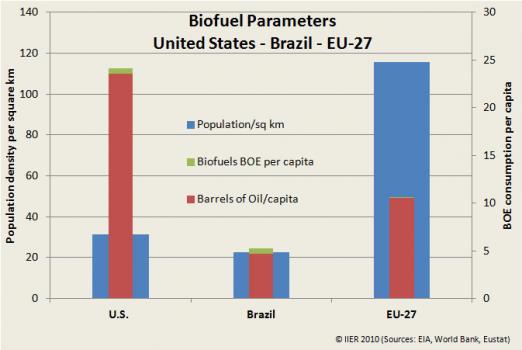Biofuels is a broad category, including ethanol from sugar-bearing plants like corn, sugarcane, and sugar beets; biodiesel made from vegetable oils; cellulosic ethanol made from woody fibers such as switchgrass and wood; and other nascent fuels like methanol. Presently, none of these alternatives seem scalable.
Only corn ethanol has any significant production volume in the U.S., which stood at 0.7 mbpd in 2009. Producing that paltry amount of ethanol consumes about one-third of the U.S. corn crop–a clear signal that it’s not a scalable replacement for oil. The U.S. production of all biofuels combined is 0.75 mbpd, or about 4% of our liquid fuel consumption.
Even Brazil’s sugarcane ethanol, which is frequently held up as a biofuel success story, only provides about 10% of its fuel needs.

Biofuel and oil usage per capita in the U.S., Brazil and the EU-27, plus population density.
Source: The Oil Drum, "The Fake Fire Brigade - How We Cheat Ourselves about our Energy Future"
As the source article for that chart put it, “There simply isn’t enough biomass potential in any Western society to produce a sufficient amount of non-fossil combustion fuels that could meaningfully replace what fossil fuels we use.”
